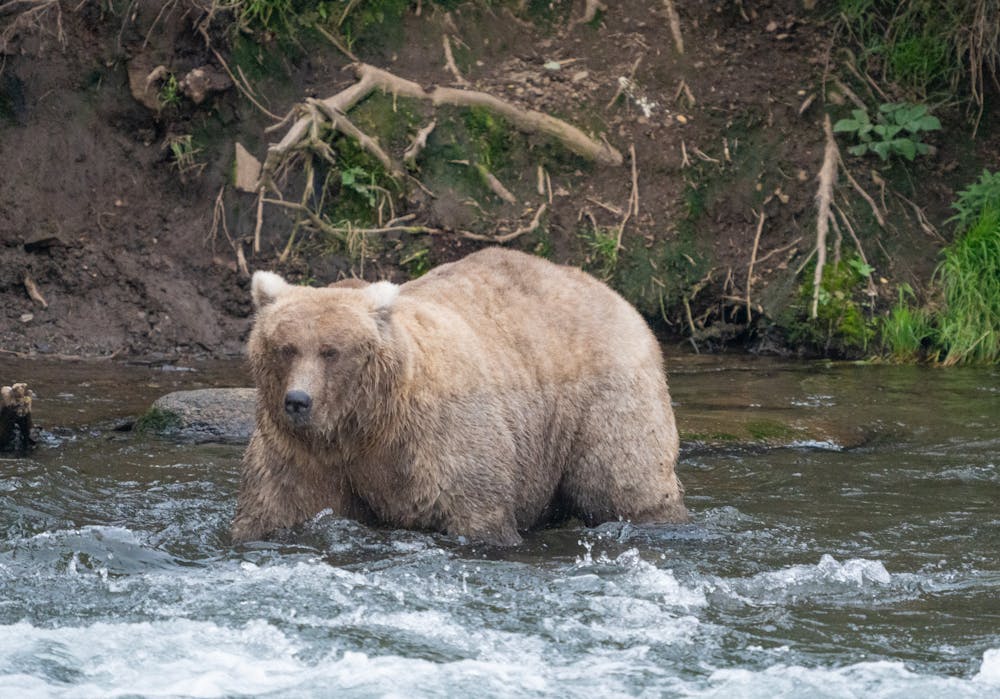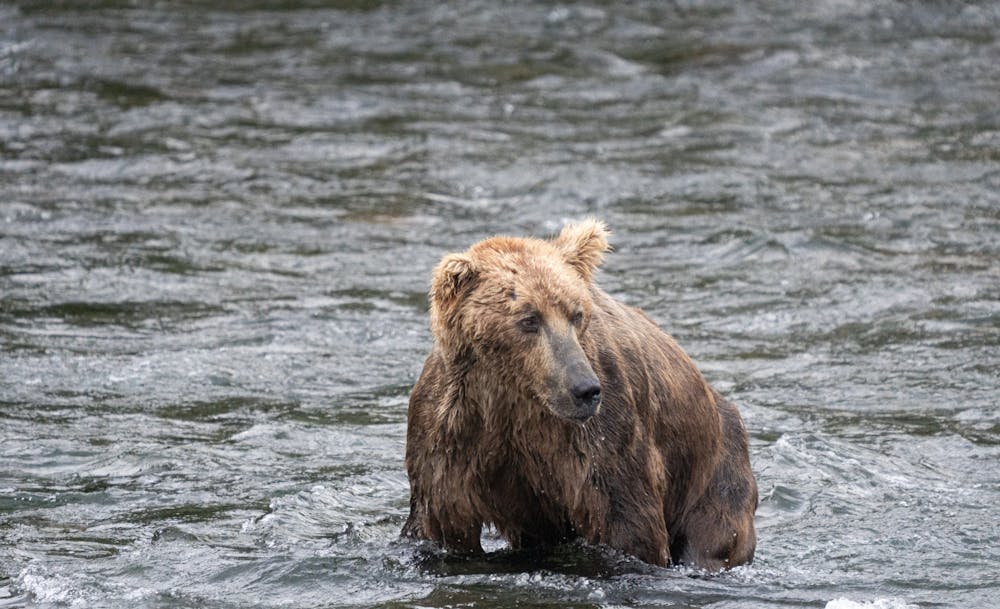By Mike Sherr
Editor-in-Chief
Every year, the Alaskan Brown Bears of Katmai National Park hunt salmon and forage to prepare for the long harsh winter months. As nature takes its course and the summer months end, millions of onlookers vote on the weight gaining transformations that a handful of bears experience.
Bear 128, Grazer, won on Sept. 10 with a lead of over 80,000 votes against Bear 32, or Chuck, after beating three other bears.
Fat Bear Week started in 2014 after former National Park Ranger Mike Fitz and other park rangers declared Sept. 30, 2014 as Fat Bear Tuesday. The group pitted 12 bears from Brooks River Falls against each other by using before and after pictures to show a bear’s transformation. Voters used likes on Facebook to show support for their favorite shaggy bears. The event became an instant hit with outdoorsy people, with over one million votes cast in 2022. The vote is now hosted by multimedia organization Explore.
The vote is extremely subjective, with voters deciding based on characteristics from heft or fur color to overall ability to cuddle.
“We rely on visitors and viewers of the bears to decide who is the fluffiest, who has put on the most weight since July,” Cynthia Hernandez, spokeswoman for Katmai, told Alaska Public Media. “You can compare who looks to be the heaviest right now, who looks to be the most round, or who you think is the cutest.”
This year’s competition was almost put in jeopardy due to the possible federal government shutdown that was avoided on Sept. 30. The National Park Service would have had to close all of the parks if Congress did not pass the continuing resolution.
With the competition continuing as planned, the National Park Service featured many great contenders, with a diverse group of veterans and newcomers.
Bear 806 Jr., winner of the 2023 Fat Bear Junior bracket, experienced his first Fat Bear Week with support from his mother, Bear 806. Mothers with cubs tend to stay away from Brooks River Falls to keep younger bears away from older, more aggressive bears. 806, however, brought her cub to the river nonetheless.
In late July, 806 fell off the falls in order to catch a fish, allowing a larger adult male bear the opportunity to attack 806 Jr. who was left alone. 806 saved her cub in time and fought off the attacker.
806 Jr. had a relatively good Fat Bear Week for being a newcomer, overcoming 3-year-old cub Bear 428 in the vote on Sept. 28. Bear 806 Jr. was voted out in the next round, however, losing to 19-year-old adult male Chunk by about 40,000 votes.
Fitz’s bracket prediction had Chunk coming out on top against Bear 747, but stated he believed that Grazer was the best bear.

The crowned champion of the 2023 Fat Bear Week, Grazer, is a dominant adult female who is an accomplished salmon hunter (Photo courtesy of Flickr/“128 Grazer (Fat)” by F. Jimenez at Katmai National Park and Preserve. September 14, 2023).
“Grazer’s formidable reputation carried into this summer,” Fitz said on his blog. “She ranked high in the hierarchy among bears and was perhaps the river’s most dominant female.”
Grazer went up against Holly, the 2019 Fat Bear Week champion, in the semifinals this year and won by over 60,000 votes.
Grazer is a roughly 20-year-old adult female bear and is one of the more dominant bears at the falls. Her win this year was her first, putting her in the Hall of Champions with other veterans like Holly and Bear 747.
The most dramatic return to the falls this year, however, was fan-favorite Bear 480, aka Otis. The 27-year-old bear was presumed dead until he was spotted on a live-feed cam in late July. Otis is a four-time Fat Bear Week champion, winning in 2014, 2016, 2017 and 2021. Older bears tend to stick to scavenging and begging for fish from other bears, but Otis went right into hunting on his own.
“There’s still really good signs that we’re seeing from [Otis],” said Felicia Jimenez, a national park ranger at Katmai. “He’s super old, but he’s still very active. When he showed up, he was immediately catching fish and those are positive signs. He’s still active, he’s still moving around.”
As a late arrival, Otis had to work hard to catch up to the younger bears. Neither his age nor lack of teeth slowed him down, helping him gain a good amount of weight.
Otis’s fashionably late appearance this year was less due to his age, however, and more related to how humans impact ecosystems. Bears usually return to hunt in salmon runs in early June, according to the Washington Post, but partly due to rising temperatures and overfishing, salmon are arriving in the river later in the season than usual.
“Things like rising ocean temperatures, overfishing, all of these things that are going to affect our marine life, are going to affect bears like Otis and all of the bears at Katmai National Park pretty directly,” Candice Rusch, a spokesperson for Explore, told the Post.

Otis on the day he was first spotted at Brooks River Falls in July (Photo courtesy of Flickr/“Bear 480 Arrives” by F. Jimenez at Katmai National Park and Preserve. July 26, 2023).
Even with less time to fatten up, Alaskan Brown Bears are still managing to hunt and scavenge enough food to get ready for their hibernating months.
Fat Bear Week is a fun and easy way to engage the public to care about conservation and environmental efforts. Millions of votes were cast in this year's competition about bears in a national park that had only about 24,000 visitors in 2021, a devastatingly small number compared to the 14 million that visited Great Smoky Mountains National Park.
“People learn more about brown bears and the salmon this way, and hopefully that [translates] to a greater sense of care for this remarkable place, as well as for bears and salmon around the world,” Fitz told the New York Times.
While Grazer does not get a salmon shaped trophy for winning the vote, they will get the less satisfying prize of just having their name on the National Park Service website. Grazer and the other furry contestants may not have known that they were brief celebrities, but by just getting fat, a small group of bears clawed their way into the spotlight.







